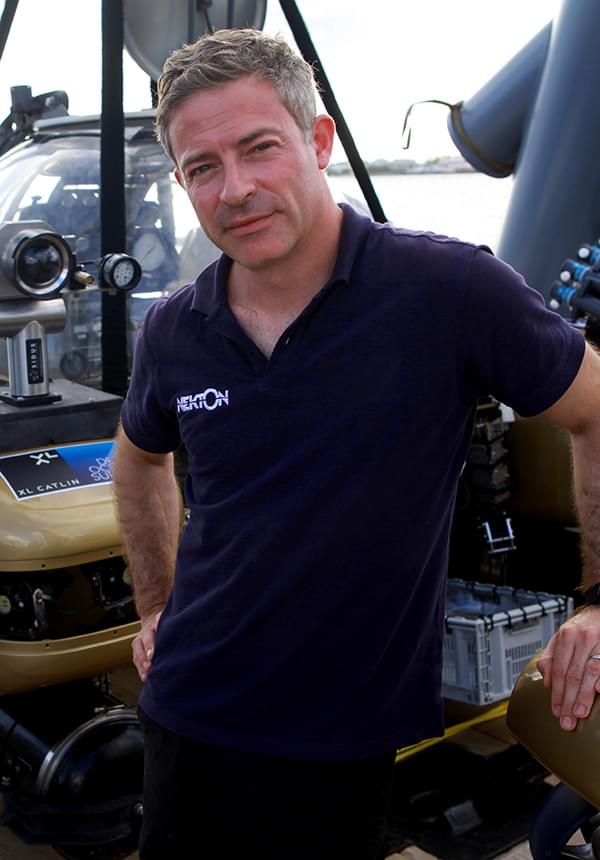
you by

How do submarines work?
For this first lesson of Submarine Live 2022, we will learn how the submersibles used by Nekton Mission work. The submersibles used by the team can take scientists 1,000 metres down into the depths of the Indian Ocean. At these depths, the pressure is one hundred times more than at sea level.
Classes will learn about the different parts of the submersible, the materials they are made from, and why they are important. The second half of the lesson will look at the principle of buoyancy and how submarines rise and dive in the ocean.
Available on catch-up
- 45 mins
- Ages 7-11 / KS2
Preparation
This lesson is a great hook for making the study of materials choices and forces real and relevant for students.
There are three student sheets that can be downloaded for this lesson. You may want to print these out for students. For the investigation, groups of students will need the materials listed on the activity page. You may wish to practice this before doing it with the class.
If you have never joined a live lesson before, visit the support centre, where you can find a range of technical and educational information.
Once booked, questions generated by your class can be submitted in advance via the Live Lessons tab in your profile.
Lesson steps
1. Introduction (5 minutes)
We welcome classes to the expedition and location, meeting our guest speaker. This is also a chance to go over the learning for the lesson and cover digital housekeeping.
2. Speaking ‘boat’ (5 minutes)
Before we get started with learning about the submersibles used by the expedition, we will practise some nautical terms together. Working at sea requires learning a whole new language. How fluent will students be?
3. Different parts of a submersible (10 minutes)
One of the submersible pilots will take students through the different parts of the submersible, the materials used, and why they are important. Students will be able to record their learning using the accompanying Student Sheet.
4. Buoyancy investigation (10 minutes)
One of the most important things that a submersible needs to do is go up and down through the ocean. Thrusters are useful to travel carefully over the seafloor, but another system is needed to control the depth. We will work together through the buoyancy investigation and find out how submersibles can explore the ocean depths.
5. Q&A (15 minutes)
This is a chance for children to ask any questions they have about the submersible and the adventures in piloting a sub through the ocean. How do you even become a submersible pilot?
Free access for Teacher Plus subscribers
Free access to this live lesson is supported by Nekton as part of their Action+ programme. Use the coupon code ILOVETHEOCEAN to receive free access to this lesson, and then email us with the action that you have taken:
- Made a class pledge to care for the ocean
- Deepen your class's understanding using one or more of the Submarine STEM investigations
- Taught one or more of the lessons from the Submarine STEM | Ages 7-11 unit
Speakers

Oliver Steeds
Chief Executive & Mission Director, Nekton
Brought to you by

How do submarines work?
For this first lesson of Submarine Live 2022, we will learn how the submersibles used by Nekton Mission work. The submersibles used by the team can take scientists 1,000 metres down into the depths of the Indian Ocean. At these depths, the pressure is one hundred times more than at sea level.
Classes will learn about the different parts of the submersible, the materials they are made from, and why they are important. The second half of the lesson will look at the principle of buoyancy and how submarines rise and dive in the ocean.
Available on catch-up
- 45 mins
- Ages 7-11 / KS2
Preparation
This lesson is a great hook for making the study of materials choices and forces real and relevant for students.
There are three student sheets that can be downloaded for this lesson. You may want to print these out for students. For the investigation, groups of students will need the materials listed on the activity page. You may wish to practice this before doing it with the class.
If you have never joined a live lesson before, visit the support centre, where you can find a range of technical and educational information.
Once booked, questions generated by your class can be submitted in advance via the Live Lessons tab in your profile.
Lesson steps
1. Introduction (5 minutes)
We welcome classes to the expedition and location, meeting our guest speaker. This is also a chance to go over the learning for the lesson and cover digital housekeeping.
2. Speaking ‘boat’ (5 minutes)
Before we get started with learning about the submersibles used by the expedition, we will practise some nautical terms together. Working at sea requires learning a whole new language. How fluent will students be?
3. Different parts of a submersible (10 minutes)
One of the submersible pilots will take students through the different parts of the submersible, the materials used, and why they are important. Students will be able to record their learning using the accompanying Student Sheet.
4. Buoyancy investigation (10 minutes)
One of the most important things that a submersible needs to do is go up and down through the ocean. Thrusters are useful to travel carefully over the seafloor, but another system is needed to control the depth. We will work together through the buoyancy investigation and find out how submersibles can explore the ocean depths.
5. Q&A (15 minutes)
This is a chance for children to ask any questions they have about the submersible and the adventures in piloting a sub through the ocean. How do you even become a submersible pilot?
Free access for Teacher Plus subscribers
Free access to this live lesson is supported by Nekton as part of their Action+ programme. Use the coupon code ILOVETHEOCEAN to receive free access to this lesson, and then email us with the action that you have taken:
- Made a class pledge to care for the ocean
- Deepen your class's understanding using one or more of the Submarine STEM investigations
- Taught one or more of the lessons from the Submarine STEM | Ages 7-11 unit
Speakers

Oliver Steeds
Chief Executive & Mission Director, Nekton
Brought to you by
